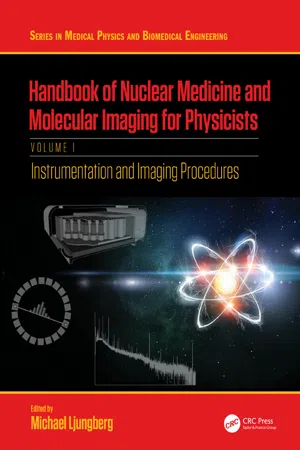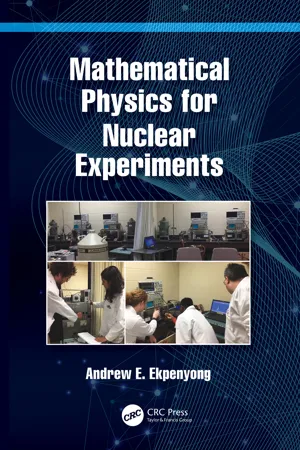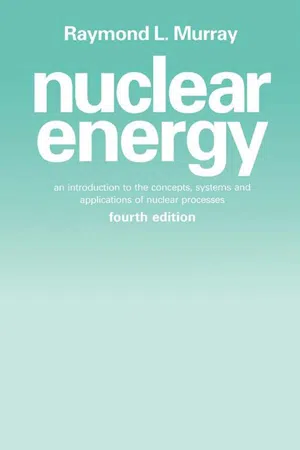Physics
Cross Section
A cross section is a measure of the probability of a particular interaction occurring between particles in a beam and a target. It is the area perpendicular to the beam that represents the probability of a collision. Cross sections are used to calculate the rate of particle interactions in experiments.
Written by Perlego with AI-assistance
Related key terms
5 Key excerpts on "Cross Section"
- eBook - ePub
Handbook of Nuclear Medicine and Molecular Imaging for Physicists
Instrumentation and Imaging Procedures, Volume I
- Michael Ljungberg, Michael Ljungberg(Authors)
- 2022(Publication Date)
- CRC Press(Publisher)
T . Thus, each process (e.g., photo absorption, Compton scattering) will have its own Cross Section and the probability that something will happen will be proportional to the sum of all separate Cross Sections.In many cases, the direction of a particle exemplified by sphere S1 will change direction according to some function, relative to its initial direction into a solid angle. This Cross Section is called the differential Cross Section and is described byf( θ ). One can also calculate a differential Cross Section describing the probability for interaction A, where particle S1 is scattered into solid angledσ A( θ )=σ A⋅ f( θ )⋅ d Ωaround scattering angled Ωθ, and the energy between E1 and E1 +dE1 can be calculated as. The general definition for a given interaction process can be described bydσ A(=θ ,)E 1σ A⋅ f( θ )⋅ h(⋅ d Ω ⋅ d Eθ ,)E 1, where P is the probability of the interaction process when one particle is irradiated by a specific type of radiation with a fluence ofσ = P / ϕϕ. The Cross Section is often given in units of barns (10-28 m2 ).3.5 PHOTON INTERACTIONS
Considering the energy interval relevant for most medical radiation physics applications (1 keV to 20 MeV), then photons passing through some material will interact with atoms through four major interaction processes, namely, photo absorption, Compton scattering, coherent scattering, and pair production. In the photo-absorption process, the energy of the photon is completely transferred to an orbital electron that will receive sufficient energy, which will be released from the atom shell. In Compton, or coherent, scattering, the photon is scattered in a new direction with or without a loss of energy, respectively. In the pair-production process, the photon interacts with the nucleus or an electron, resulting in the conversion of photon energy into a positron/electron pair that shares the residual kinetic energy. These four processes are now discussed in more detail. - eBook - ePub
Nuclear Engineering Fundamentals
A Practical Perspective
- Robert E. Masterson(Author)
- 2017(Publication Date)
- CRC Press(Publisher)
4Nuclear Cross Sections and Reaction Probabilities
4.1 Nuclear Cross Sections and Their Uses
When scientists first began to explore the structure of the atom, they were surprised to learn that the atom consisted primarily of empty space and that within this empty space there was a very small and extremely dense structure called the atomic nucleus , which was later discovered to have a diameter of about 10–12 cm (see Chapter 1 ). When they attempted to shoot other particles into the atom to break it apart, they found that the particles normally went right through the atom without hitting anything at all! Their experiments were equivalent to shooting a bullet into a haystack that has a small metal object (which is represented by the nucleus) inside of it. (In a real haystack, the nucleus would be about the size of a flea.) Most of the time, the bullet hits nothing but straw and passes completely through the haystack. However, occasionally it hits the metal object inside of it and scatters or ricochets away. Refer to Figure 4.1 to visualize the dynamics of this process. In the early days of the nuclear industry, scientists invented a way to measure the probability that an incoming particle (such as a neutron) would actually “hit” the nucleus and cause a nuclear reaction to occur. For this purpose, they invented the concept of the nuclear Cross Section.Essentially, a nuclear Cross Section is a convenient way of measuring the probability that an incoming particle will hit the nucleus (or another comparably sized object like an electron) and, as the result of that collision, cause a particular nuclear reaction or set of reactions to occur. There is a direct correlation between the size of a nuclear Cross Section and the cross-sectional area of the nucleus that the incident particle is trying to hit. A larger cross-sectional area means that there will be a higher probability for a reaction to occur, and a smaller Cross Sectional area means that the probability will be lower. The standard unit for measuring nuclear Cross Sections is a unit called the barn , (σ), which has a value of 10−24 cm2 . Hence a barn is roughly equivalent to the cross-sectional area of an atomic nucleus (i.e., A = π*D2 /4, where the diameter of the nucleus D is about 10–12 cm). (Refer to Figure 4.2 to get an idea of exactly how small a cross-sectional area of 10–24 cm can be.) In comparison, 1 Angstrom , a common unit for measuring the wavelength of light in the fields of chemistry and optics, is about 10–8 cm, and the atomic nucleus itself is about 1 femtometer (1 × 10–12 cm) in diameter. Hence the electron cloud in Figure 4.2 is about 1 Angstrom in diameter, while the nucleus is about 10,000 times smaller than this. Historically, the term “barn” was invented because it was believed that the early scientists who were shooting particles at the nucleus were having a hard time hitting the broad side of a barn - eBook - ePub
- Andrew E. Ekpenyong(Author)
- 2022(Publication Date)
- CRC Press(Publisher)
Just to ensure physical intuition over the results, we note that the scattering Cross Section is the effective area for collision. For instance, the Cross Section σ of a spherical target is π r 2. For a single photon incident on a slab of material of area A, containing one target of cross-sectional area σ, the probability of the photon interacting with the target will be the ratio of the two areas, σ A. If the slab of material A contains n targets, then the probability of interaction is n σ A and this is indeed the fraction of the area occluded or blocked off by the targets. In the processes of interests, the targets are atomic nuclei, atoms themselves, electrons and molecules. No wonder interaction cross-sections are conventionally expressed in a unit of area called the barn where 1 barn = 10 − 28 m 2. Moreover, the cross-sections we cover are those for the important photon interactions with atoms of the absorber or scatterer, namely: photoelectric effect, the Compton effect, pair production in the nuclear field, pair production in the electron field (also known as triplet production) [52]. 5.2 PHOTOELECTRIC CROSS-SECTION AND BORN APPROXIMATION 5.2.1 Photoelectric Effect The atomic photoeffect or photoelectric effect is the emission of atomic electrons or other free carriers when photons hit a material and disappear. Einstein explained the phenomenon in 1905. He was awarded the Nobel Prize in 1921 for “his discovery of the law of the photoelectric effect”. The photoelectric effect is basically an interaction mechanism between photons and atomic electrons. Einstein explained that one incident photon with energy E γ is absorbed by the atom, leading to the emission of one electron with energy E e, depending on the binding energy of the atom, E B, or in the case of metals, the work function, Φ - eBook - ePub
Nuclear Energy
An Introduction to the Concepts, Systems, and Applications of Nuclear Processes
- Raymond L. Murray(Author)
- 2013(Publication Date)
- Pergamon(Publisher)
−15 m).Although we cannot see nuclei, we imagine them to be spheres with a certain radius. To estimate that radius, we need to probe with another particle—a photon, an electron, or a gamma ray. But the answer will depend on the projectile used and its speed, and thus it is necessary to specify the apparent radius and Cross Sectional area for the particular reaction. This leads to the concept of Cross Section, as a measure of the chance of collision.We can perform a set of imaginary experiments that will clarify the idea of Cross Section. Picture, as in Fig. 4.2(a) a tube of end area 1 cm2 containing only one target particle. A single projectile is injected parallel to the tube axis, but its exact location is not specified. It is clear that the chance of collision, labeled σ (sigma) and called the microscopic Cross Section , is the ratio of the target area to the area of the tube, which is 1. In Computer Exercise 4.A the programs MOVENEUT and CURRENT show graphically the flow of neutrons in a column.FIG. 4.2 Particle collisions.Now let us inject a continuous stream of particles of speed v into the empty tube (see Fig. 4.2(b) ). In a time of one second, each of the particles has moved along a distance v cm. All of them in a column of volume (1 cm2 ) (v cm) = v cm3 will sweep past a point at which we watch each second. If there are n particles per cubic centimeter, then the number per unit time that cross any unit area perpendicular to the stream direction is nv , called the current density .Finally, Fig. 4.2(c) we fill each unit volume of the tube with N targets, each of area o as seen by incoming projectiles (we presume that the targets do not “shadow” each other). If we focus attention on a unit volume, there is a total target area of N σ. Again, we inject the stream of projectiles. In a time of one second, the number of them that pass through the target volume is nv; and since the chance of collision of each with one target atom is σ, the number of collisions is nvN - eBook - ePub
- David Bohm(Author)
- 2012(Publication Date)
- Dover Publications(Publisher)
To compute the probability that in the short time dt a given particle collides with another, consider a cylinder with a base of area of πd 2 and height equal to the distance dx = υ dt traveled by the particle during this time. The probability of collision is then just equal to the probability that the center of another particle lies in this cylindrical region. In terms of the particle density ρ, this probability is just Strictly speaking, this probability is correct only for times so short that dP is small. This is because if we wait a longer time, the cylinder discussed above may contain so many molecules that some will get in the way of others, i.e., some may be in the shadows of others. This situation is illustrated in Fig. 1. The molecule A is the one that we are following. Because it can strike B, the probability of striking C is reduced since it may be deflected or brought to rest before it strikes C. When the path is so long that the probability of collision is large, one must discuss the possibility of more than one impact; this requires a theory of multiple scattering. * We shall not treat the case of multiple scattering, however, and shall restrict ourselves to thicknesses of matter so small that multiple scattering may be neglected. This restriction means a “thin” target, as opposed to a “thick” target. F IG. 1 3. Definition of Cross Section. The probability that a particle will be scattered as it traverses a given thickness of matter dx can be expressed in terms of a quantity called the “scattering Cross Section.” To do this, let us note that each molecule presents to the oncoming particles a target area equal to σ = πd 2. This target area is just a Cross Section of the region within which a collision can take place, as viewed along the direction of motion of the beam
Index pages curate the most relevant extracts from our library of academic textbooks. They’ve been created using an in-house natural language model (NLM), each adding context and meaning to key research topics.




